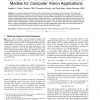Free Online Productivity Tools
i2Speak
i2Symbol
i2OCR
iTex2Img
iWeb2Print
iWeb2Shot
i2Type
iPdf2Split
iPdf2Merge
i2Bopomofo
i2Arabic
i2Style
i2Image
i2PDF
iLatex2Rtf
Sci2ools
PAMI
2006
2006
Estimation of Nonlinear Errors-in-Variables Models for Computer Vision Applications
In an errors-in-variables (EIV) model, all the measurements are corrupted by noise. The class of EIV models with constraints separable into the product of two nonlinear functions, one solely in the variables and one solely in the parameters, is general enough to represent most computer vision problems. We show that the estimation of such nonlinear EIV models can be reduced to iteratively estimating a linear model having point dependent, i.e., heteroscedastic, noise process. Particular cases of the proposed heteroscedastic errors-in-variables (HEIV) estimator are related to other techniques described in the vision literature: the Sampson method, renormalization, and the fundamental numerical scheme. In a wide variety of tasks, the HEIV estimator exhibits the same, or superior, performance as these techniques and has a weaker dependence on the quality of the initial solution than the Levenberg-Marquardt method, the standard approach toward estimating nonlinear models.
Related Content
| Added | 14 Dec 2010 |
| Updated | 14 Dec 2010 |
| Type | Journal |
| Year | 2006 |
| Where | PAMI |
| Authors | Bogdan Matei, Peter Meer |
Comments (0)

